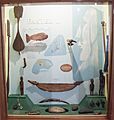Father Sebastian Englert Anthropological Museum facts for kids
| Museo Antropológico Padre Sebastián Englert | |
 |
|
| Established | 1973 |
|---|---|
| Location | Hanga Roa |
| Type | Archaeological and ethnographic |
| Collection size | 15,000 |
The Father Sebastian Englert Anthropological Museum is a special place on Rapa Nui, also known as Easter Island, in Chile. It's a museum located in the town of Hanga Roa. This museum is named after a Bavarian missionary, Father Sebastian Englert. It opened in 1973. The museum's main goal is to protect and preserve the amazing culture and history of the Rapa Nui people.
The museum is managed by the Chilean National Service of Cultural Heritage. It is also home to the William Mulloy Library, which has many books and papers about the island.
About the Museum
The museum was started in 1973. It is named after Sebastian Englert because he spent a lot of time studying the language and culture of Easter Island. During his research, he collected many important objects. These objects became the first part of the museum's collection.
What's Inside the Museum?
The museum has about 15,000 objects in its collection. These include items collected by Sebastian Englert himself. It also holds records from many years of archaeological digs on the island. Some archaeological finds include human remains from these excavations.
Special Objects You Can See
The museum is home to the only female mo‘ai statue ever found. It also has one of the special coral eyes that were placed in the mo‘ai statues. You can see tools made from obsidian stone, small wooden statues, and old fish hooks. There is also a large collection of photographs and recordings of traditional music. The museum also shows examples of rongorongo glyphs, which are ancient writings from the island.
The museum also collects items related to nature. For example, it has bones from sea animals like whales. This includes two large bones from a blue whale.
The William Mulloy Library is part of the museum. It has a huge collection of scientific books and papers about Easter Island.
Rapa Nui Objects Around the World
Many important Rapa Nui objects are kept in museums in other countries. This happened because of historical events and the work of international researchers. For example, the University of Wyoming Art Museum has a collection of 180 small sculptures. These are made from volcanic rock, stone, and wood. More than 70 mo'ai statues are in museums outside of Easter Island. Some are at the British Museum and the National Museum of Natural History in the United States.
Pictures of Objects in Other Museums
-
Rapa Nui objects at Otago Museum
-
A Mo'ai at the National Museum of Natural History
-
A staff or club at the Honolulu Art Museum
Bringing Objects Home (Repatriation)
Repatriation means bringing cultural objects or human remains back to their original home. This is a very important process for the Rapa Nui people.
Human Remains
Since 2013, there has been a special program to return and rebury ivi tupana (human remains). This program is led by the Rapa Nui community. Researchers and the museum work together on this. On Rapa Nui, human remains are not seen as property of the Chilean government. They must be returned directly to the community.
Kon-Tiki Voyage Items
In 2019, the governments of Norway and Chile made an agreement. This agreement allowed cultural items and human remains to be returned. These items were taken during Thor Heyerdahl's research trips between the 1950s and 1980s. The returned objects are now part of the museum's collection.
Mo'ai Statues
In 2006, a Chilean artist named Rosa Velasco helped bring a mo'ai statue back to the island. She had inherited it from her father. In 2018, New Zealand returned two mo'ai statues. These came from the Te Papa Museum and the Otago Museum. There is also a famous mo'ai called Hoa Hakananai'a at the British Museum. The Rapa Nui people formally asked for its return in 2019. The British Museum reportedly agreed to loan it.
Digital Repatriation
As of 2021, there was a project to share digital copies of objects. This project is part of the partnership with the University of Wyoming. The goal is to share digital models and files of objects in their collection. This could allow both museums to have exhibitions using the same materials in the future.
Pictures of Objects Requested for Return
-
A Mo'ai from Otago Museum, before it was returned
-
The famous Hoa Hakananai'a mo'ai
Awards and Recognition
In 2006, the museum received an award from UNESCO. It won the "INFOLAC Web 2005 Contest" for being the best online museum with a scientific focus.
See also
 In Spanish: Museo Antropológico Padre Sebastián Englert para niños
In Spanish: Museo Antropológico Padre Sebastián Englert para niños









